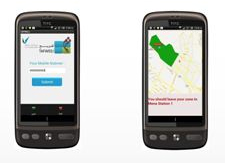Saudi Researchers Collaborate with Calit2 on Mobile Apps
San Diego, Calif., Oct. 1, 2012 — For decades, Saudi Arabia has been dependent on oil reserves as its primary economic driver. But under the leadership of its current monarch, King Abdullah, the Kingdom is transitioning into a knowledge-based society — a transition reflected in the recent collaboration between researchers from the King Abdulaziz City for Science and Technology (KACST), Saudi Telecom Company (STC) and colleagues at the University of California, San Diego.
|
Chockalingam, who previously developed the San Diego Wireless Traffic Report for Calit2, usually works with his Saudi colleagues using Skype and emails, and did so with Al-Otaibi and Al-Ghunaim for eight months prior to their visit to UCSD.
Once in San Diego, Al-Otaibi and Al-Ghunaim lived in student housing while continuing to work with Chockalingam on two smartphone apps they’ve been developing along with their mentor at KACST, Saleh Al-Harthi, who is affiliated with STC. Both apps pertain to crowd control: One is designed to assist authorities to control crowds when Muslims make the annual pilgrimage to Mecca (known as the ‘Hajj’) and the other app addresses the area of traffic engineering and border crossing.
Although the KACST researchers were well-versed on programming for the client-side (developing the software embedded in the phone itself), they enlisted Chockalingam to provide training on the server-side of the programming equation, which handles the software’s remote operations. Chockalingam also provided training on iPhone programming and encouraged Al-Otaibi and Al-Ghunaim to present their results to Calit2 Director Ramesh Rao — something that was also useful to them.
“It only took a week for them to be up-to-speed on the server side,” says Chockalingam of the researchers, “so I pushed them to be the ones to present the research, instead of me. Now that they have both skills, they’re capable of developing an app themselves.
“It’s like that saying goes about teaching someone to fish … Well, they came here and they learned how to fish,” he continues. “They were very motivated, and it was a pleasure to work with them.”
Al-Otaibi and Al-Ghunaim call the experience working with Calit2 invaluable.
“We had the biggest chance of our careers to receive this kind of training,” says Al-Otaibi. “Because we were able to work with experts in this field, we learned a lot from it. It’s difficult to find the same kind of experience in Saudi Arabia.”
Adds Al-Harthi, “Of course, you can learn about programming anywhere — you can buy the books and attend the classes anywhere — but the idea with this collaboration is to merge ideas and to work with different researchers to achieve more diverse and fruitful results and to transfer knowledge between researchers. With this approach, you cannot help but be fascinated by how things are created when you mix different brains together.”
Calit2 will continue working with Al-Otaibi and Al-Ghunaim as well as with Tarfah Al-Rashed, a female graduate student in UCSD’s Computer Science and Engineering Department who previously worked in KACST’s ComputerResearch Unit and received a scholarship from KACST.
Calit2 has maintained a partnership with KACST/STC since 2010 and with the King Abdullah University for Science and Technology (KAUST, which is also based in Saudi Arabia) since 2008. Under a four-year agreement with KAUST, for example, Calit2 has provided expertise in visualization, virtual-reality and collaboration tools to support KAUST’s ambitious plan to deploy state-of-the-art technologies for scientific research.
The KACST/STC partnership includes visualization and virtual-reality as well as wireless networking, mobile applications and health and medical applications and research. Last fall, the Visualization team worked closely with three visiting KACST engineers on newly-developed technologies that were displayed last January at the KACST booth at Janadriyah, a national fair held in Riyadh, Saudi Arabia.
“We’re hoping to expand the relationship and are hoping to recruit more researchers to the program we’ve developed at KACST so we can continue to utilize this model of collaboration,” notes Al-Harthi. “This knowledge-transfer business is extremely important for us in Saudi Arabia, and the more people who can benefit from this knowledge transfer the better. The collaboration is part of a bigger vision for science and technology in Saudi Arabia developed by KACST under the leadership of KACST’s President, his excellency Dr. Mohammed Al-Suwaiyel, and the Vice President of KACST for Research Institutes, Prince Turki Bin Saud Bin Mohammed AlSaud. We definitely have plans to repeat the experience in the future. We are very optimistic about the potential of these collaborations.”
Related Links
Media Contacts
Tiffany Fox, (858) 246-0353, tfox@ucsd.edu

